(This blog post was originally posted on Bouke’s personal blog. Bouke is a master student in the Nikhef Dark Matter group and is in Japan for an internship with the KamLAND-Zen collaboration at Tohoku University in Sendai, Japan. Read more about his trip in the Nikhef news article)
Time flies! It’s been several months since I first set foot in the grand arrival hall of Tokyo Narita Airport, searching for the easiest route to Sendai. Although I still make many mistakes every day — especially where speaking Japanese is involved — I think I’ve grown a lot since then. Even more so, I’ve come to understand how incredibly much there is still to learn.
Last weekend, I had the opportunity to attend an international symposium on low background particle physics research1. RCNS being one of the principal organisers, neutrinoless double beta decay formed one of the main topics. But there were plenty of talks on other fascinating subjects as well. Among them were direct detection efforts for dark matter, supernova neutrino’s and the cosmic neutrino background. Although I would like nothing more than to give a good overview of each and every one of them, I’m afraid I possess neither the time nor expertise to do so at the moment. However, I didn’t start this article to leave you empty-handed!
One topic really grabbed my attention, not only because it’s very relevant to the experiment that I’m involved in, but also because it’s important to many other disciplines within my general research field. Therefore, I will dedicate the coming blog entries to the advent of irreducible backgrounds and ways to look beyond them.
To be or not to be…
So what do I actually mean when I speak of irreducible backgrounds? And how do you move around them? I’m afraid there is no single answer to these questions. In fact, there might be as many replies as there are different experiments: each comes with its own location- and detector-specific considerations. To make things a little more concrete, I will focus on my own research field of neutrinoless double beta decay for the time being.
A quick refresher: neutrinoless double beta decay forms an, as of yet, unobserved exotic process, where two neutrons simultaneously decay into protons by shedding two electrons. However, contrary to the traditional models, where such a decay is always accompanied by the emission of two antineutrinos, neutrinoless double beta decay occurs without them. This violates a symmetry, called lepton number conservation, which had previously been considered fundamental. So you might expect theoreticians to call us to a halt. But the converse is actually true.
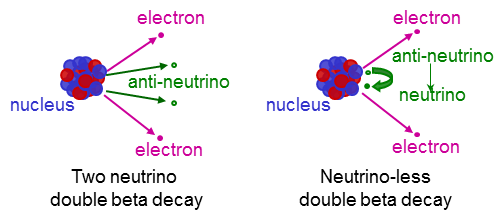
There are many theoretical arguments in favor of lepton number violation. A few of them are related to some of the deepest and oldest questions which have preoccupied mankind. For example: why is there something instead of nothing?
In the universe we observe principally two categories of matter: particles, first of all, and, antiparticles, secondly. Together they compose the entire observable universe. However, if we assume that both were created equally at the beginning of time, we would end up with a void. Particles and antiparticles annihilate to form photons. Hence, if a bias towards regular matter were to be missing, we would not observe the structures we see today: no planets, no stars, no galaxies and, certainly, no questioning humans. Lepton number violation would provide a nice leeway to explain this apparent discrepancy between theory and reality. If I have time, I will dedicate a separate entry to the subject in the future. For now, however, it’s sufficient to know that neutrinoless double beta decay requires a break with current theory and that an observation of the process could provide a first clue towards solving the origins of the matter-antimatter asymmetry.
Listening for the bell
All good and well. But how do we actually observe the process? In a previous blog entry, I explained some of the inner workings of the KamLAND-Zen experiment. Reducing the detector to its core components, we can say that KamLAND-Zen consists of a four-stage Matroyshka: the outer layer (the outer detector) serves as a veto against highly energetic, charged particles from outer space. The second layer constitutes the main experimental vessel (the inner detector). 1879 PMTs lined up along the edge of this vessel, collectively scour its contents for a specific type of light. This light is generated in the final two Matroyshka’s (the outer and inner balloon). The first one is filled with a sticky substance called KamLAND liquid scintillator, which flares up whenever particles transfer energy to it. The second one contains a mixture of liquid scintillator and 90% enriched 136Xe isotopes. If the Xenon isotopes undergo neutrinoless double beta decay, we expect to observe corresponding signals from the energy-deposition of the two ejected electrons into the liquid scintillator.
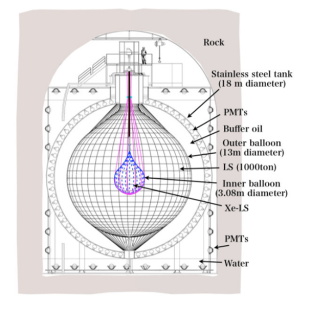

I like to compare this mechanism to the strings of wind chimes which sometimes hang under the roofs of Japanese temples and shrines. Imagine throwing a nut or marble along the length of the string3. Depending upon the type you use and the force at which you throw it, the nut will sound a different number of chimes. Throwing a skippy ball instead might ring the first chime much louder, but will probably not sound many bells in total. We say that the stopping power is much higher for the skippy ball than for a chestnut. In this manner, different kinds of projectiles and different throwing speeds will result in different kinds of sound, originating from different locations along the line, just like different kinds of particles (alphas, betas or gammas) moving through the liquid scintillator at different energies give rise to different flashes of light. In KamLAND-Zen we “listen” for the unique sound, originating from a neutrinoless double beta decay event. The two electrons emitted during this process, deposit a very specific energy into the liquid scintillator, generating a characteristic light signal which we try to observe with 1879 PMTs.
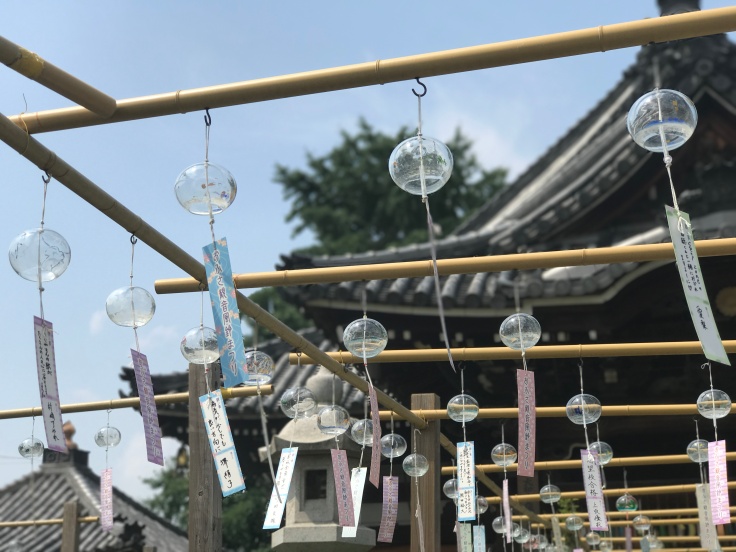
The caveat
That sounds simple enough. We simply prick up our ears and wait for the correct sound to fly by. If only it were that easy…
Those who have been to a Kyoto shrine, will know that any sound of wind chimes is generally overwhelmed by the squeals, and camera flashes of wandering tourists4. Similarly, the flash of light originating from a neutrinoless double beta decay, is generally outshone by other sources of light, such as decays of radio-active isotopes and the passing of cosmic rays. Only by removing these spurious signals, can neutrinoless double beta decay be revealed. The field has seen staggering progress in terms of reducing backgrounds. For example, background rates due to radio-active decays in the so-called Uranium-chain amounted to approximately 0.2 events per ton per day at the start of KamLAND-Zen in 2011, but could be brought down to less than 0.03 events per ton per day by 2016 (a factor 10 improvement in less than five years time!)5.
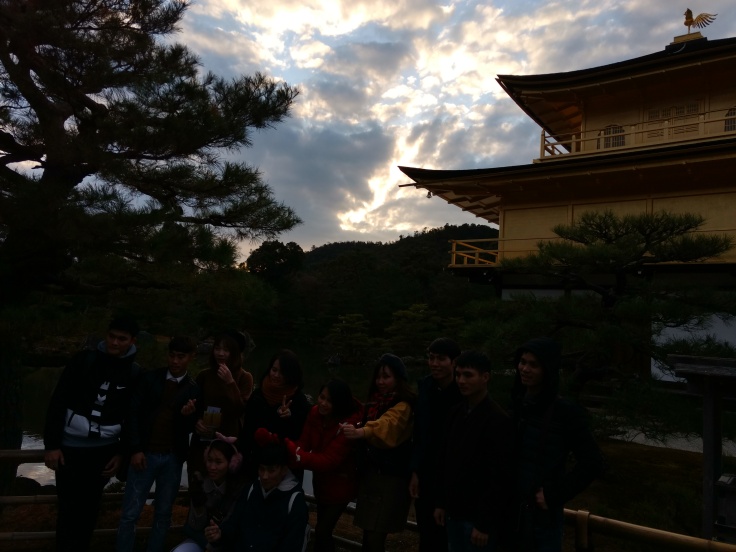
Although we haven’t reached the point quite yet, the neutrinoless double beta decay community is slowly encroaching upon a level of radio-purity and background reduction where the new, dominant background is constituted by so-called electron recoils (ERs). Omitting the details, these events occur when neutrinos originating from the sun, bump into one of the orbital electrons of an atomic nucleus and, in so doing, release the electron from its host. The freed electron may assume a range of different energies, depending upon the initial energy of the scattering neutrino (among other factors). And you guessed it: the energy associated with a neutrinoless double beta decay is one of them.
Electron recoils are especially pesky, since they cannot easily be removed. They cannot be shielded against, because neutrinos barely interact and will penetrate any obstacle you put in their way6. Moreover, they cannot be reduced since there is no method to turn down the sun (fortunately!). As such, identifying electron recoils requires innovative tagging methods, which may pick these types of events apart from others.
Reaching beyond the horizon
So what distinguishes an electron recoil from a neutrinoless double beta decay? Quite a lot! A quick glance at a simple diagram of the two processes, reveals more disparities than similarities. Electron recoils require the input of two particles (the nucleus and a neutrino); neutrinoless double beta decays start with one (the nucleus only). More importantly, neutrinoless double beta decays involve two charged particles (the two output electrons), whilst electron recoils only yield one charged particle (a single output electron). This last fact forms the principal motivation for developing technologies that distinguish between the two.
So how do you tell apart a single electron from a pair? One way would be to employ electric or magnetic fields: a charged particle subjected to an EM field will experience a force proportional to the strength of the field and slowly accelerate as a consequence. This results in curved trajectories which can be traced by various types of detector such as trackers or time-projection chambers (TPCs).
At present, there are several neutrinoless double beta decay experiments which try to exploit EM fields. The most important ones are Super-NEMO, a hybrid calorimeter-tracking device which measures the energies and trajectories of internal events simultaneously, and high-pressure gaseous Xenon TPCs such as NEXT, PandaX-III and AXEL, which measure ionization tracks of particles moving through the detector and (depending upon the experiment) flashes of light accompanying such motion.
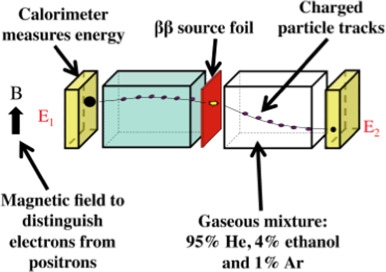
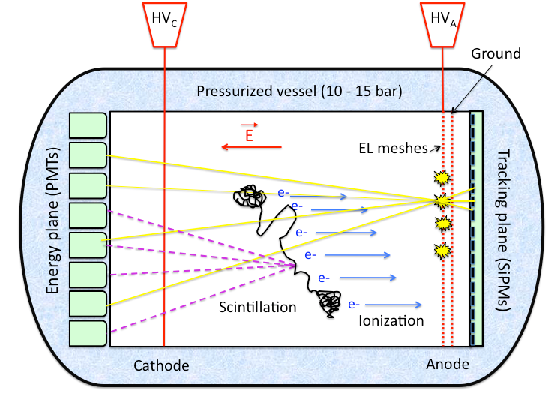
Although tracking detectors are very effective at picking out charged particle signals, they come at the cost of having to maintain very stable EM fields. This is not a small feat and considerable effort usually goes into developing the experimental soft- and hardware which allow for minute control of associated parameters.
Setting up uniform electric or magnetic fields within KamLAND-Zen is impossible. After all, the detector was not designed with charged particle readout in mind. But there are other methods we may employ to distinguish signals. An American group of KamLAND-Zen collaborators9 is currently looking at ways to veto electron recoils, using time differences between scintillation and Cherenkov light associated with single events. I’m going to leave the details for the next blog entry. But for now, let me end on the note that these time differences are extremely tiny and that measuring them will be very hard.
Neither two aspects deter a good experimentalist from trying, of course! In the coming entry I will dissect some of the currently available information on their experiment, in an attempt to show why the Winslow Lab feels optimistic about this endeavour. Until then!
Footnotes
1. The official website of the symposium on “Revealing the History of the Universe with Underground Particle and Nuclear Research” can be found here.
2. The UC Davis neutrino group has been working on the SNO+ experiment, among other subjects. See this website for more information.
3. In all seriousness, please don’t! I would hate to be evicted for promoting sacrilege!
4. Granted: I have no right to complain whatsoever, considering that I formed part of the problem, much more so than subject to it. But that didn’t prevent me from noticing!
5. See table 1 of this KamLAND-Zen paper.
6. I heard a great thought experiment this weekend, which illustrates this clearly. The current go-to method for shielding against radiation is to put up thick lead walls. Nuclear reactors commonly employ several of these lead shielding constructions to protect against the most immediate hazardous sources of radioactive decay. To stop a neutrino in the same manner, however, would require the construction of a lead wall at least the size of our entire galaxy (some 50 kiloparsecs, or 1.5 quintillion km, in diameter)!
7. See this website for additional information on the experiment.
8. The NEXT collaboration website can be found here.
9. Their experimental research projects can be read about here.